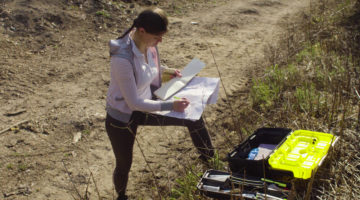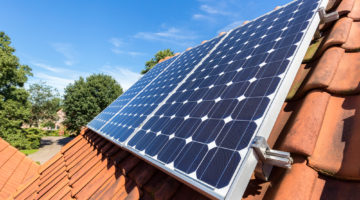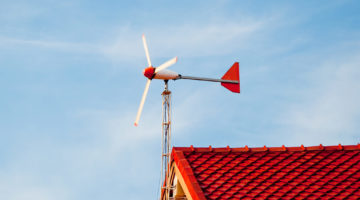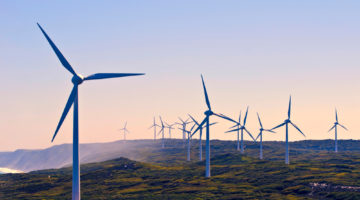
Wind power is quite an inviting form of power. Looking at it on offshore wind farms, and those big onshore turbines that you see, it seems like a great way to generate renewable energy. Why then, don’t we see micro turbines on everyone’s roof? Surely if it makes sense for a farmer to have a big turbine in a field, it makes sense for everyone to have a little turbine of their own?
Windspeed is power
Firstly I should explain that windspeed is not just proportional to generating power, but it is exponentially proportional. A doubling of the windspeed will produce eight times the power, so a small increase in windspeed will mean a big increase in power, but equally a small drop will cause a big reduction in power.
The problem for micro turbines is that they are not going to be very high off the ground. If they are mounted on roofs, they are perhaps 5 or 6 meters up, but wind speeds massively reduce as you approach the ground, and things like houses and roofs will cause friction as well, so even if your turbine is on a nice tall building, it is going to suffer from some drag as a result of the turbine being so close to the building. Tall turbines in fields can be 20 or 30 metres tall, and therefore avoid this problem.
Unfortunately any structure extending above the roofline will need planning permission, and in a built up area there is a good chance you won’t get that, so you are stuck with a turbine close to the ground, with quite a few obstacles around creating drag.
Blade length makes a big difference
Windspeed is crucial, but equally so is the length of the blades on your turbine. In the same way as well, there is an exponential proportionality that means the bigger the blade, the more power.
This is because the power generated is proportional to the swept area of the turbine (the space the blades pass through), rather than the length themselves. The area of a circle, as we know, is πr2, so the swept area is going to be much greater for each meter you add to the blade length. A 2m blade length for example, will create a swept area of 12.56m2, whereas a 4m blade will create an area of 50.27m2. If you have the space, money and permission to put up a big turbine with a huge blade size, then you are going to be generating a massive amount of energy, but at the sort of size a garden turbine is going to have to be, there really is not much swept area to generate your electricity.
Whilst a big blade on a farm where wind speeds are high might produce many megawatts of energy, a turbine in your garden just isn’t, for both of these reasons just discussed.
How much energy can a garden turbine generate?
Bearing these two important factors in mind, it is easy to reach the conclusion that you either need a windy spot for your turbine , or a really big blade size. If your garden has neither of these qualities, chances are a wind turbine is not for you. In the below chart I have provided some potential wind speeds and blade sizes, and then worked out the output of the turbine. This should give you a good idea of how much power you can generate.
| Wind Speed | Size of Turbine (diameter of blades) | Output |
| 12m/s | 1.5m | 366 Watts |
| 9m/s | 1.5m | 155 Watts |
| 6m/s | 1.5m | 45.8 Watts |
| 3m/s | 1.5m | 5.7 Watts |
| 12m/s | 3m | 1.47 KW |
| 9m/s | 3m | 618 Watts |
| 6m/s | 3m | 183 Watts |
| 3m/s | 3m | 22.9 Watts |
| 12m/s | 6m | 5.86 KW |
| 9m/s | 6m | 2.47 KW |
| 6m/s | 6m | 733 Watts |
| 3m/s | 6m | 91.6 Watts |
| 12m/s | 12m | 23.5 KW |
| 9m/s | 12m | 9.9 KW |
| 6m/s | 12m | 2.93 KW |
| 3m/s | 12m | 366 Watts |
Let’s try and put some of these figures in perspective. WIndspeed can be a little tricky to put into context. What exactly is 3 m/s? I am going to put it into the context of the Beaufort Scale, which illustrates wind speed really well. 3m/s is the equivalent of force 2, which can be described as the point at which you can feel the wind hit your face, or a light breeze. 6m/s is a moderate breeze, where small branches move and dust can be moved around. By the time you get to 12m/s you are looking at a ‘Strong Breeze’ or force 6. At this point small trees are swaying and big branches moving. It is just a bit short of a full blown gale.
I think it is fair to say that 12m/s is not the sort of speed you are going to typically experience in your garden, even if your turbine is strategically placed on your roof. In fact, the average wind speed for the average home roof in the UK is about 4-5m/s. This will give you an average power of around 20-30 Watts for a 1.5m turbine or maybe 100 watts for a 3m turbine. That is not a lot of power when you compare it to a solar PV system, which will produce more than twice the power with just one panel. It is enough to power a few light bulbs for example.
When you do get decent wind speeds however, you are going to produce a lot more you say? Well, yes, but even at 12m/s a 3m diameter turbine is going to produce 366 watts, not far off the capacity of 2 PV panels. Not hugely impressive.
How about a turbine for off grid applications, like camping?
As you may have spotted in the EcoStore, we do sell a few different models of 12 volt turbines, specifically designed for use on caravan sites and on camping trips. The difference in these applications is that you are more likely to be in an exposed position, so wind speeds are likely to be higher, whilst you tend to need a lot less energy in a camper, so the wind power can contribute a fair bit more.
Should I get a wind turbine?
Honestly, if you are interested in renewable energy, you should look at solar PV as a first option, but if your home is in an exposed windy area, and you can put up a decent sized turbine with a bit of elevation, it can be a really good option. For the average suburban home, I fear it just won’t be worthwhile.
Think we missed something? Do you have a different opinion?
Comment below to get your voice heard…












Hi we have a 3.9 kw solar array with a nedap pr37 sb-bs/s240 inverter with 4 x sbs 190f batteries .The batteries need additional charge as they are always in a protection charge in the winter.Could a small wind turbine help to charge them.
Hi, a Wind turbine will definitely work but you will need a charge controller to control the charge from the wind turbine to the battery.